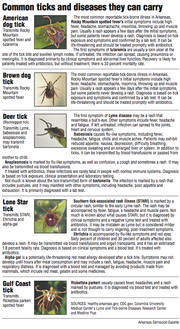Editor's note: This is the second part of two-part series about Lyme disease in Arkansas. Part one, about how the disease is diagnosed, appeared in Sunday's Style section.
In September 2008, Marie Batey of Beebe went camping along the Buffalo River. Two weeks later, she fainted at her retail job. She had felt "off" that day, but didn't think she was sick enough to miss work. Her sister, Renee Butler, took Batey to Baptist Health Medical Center in Little Rock and, while helping her change into a gown, noticed a perfect bull's-eye rash on the back of Batey's thigh.
A nursing student, Butler insisted on a Lyme test. Ultimately Batey was tested twice, once at the hospital and later by her primary care doctor. Both times, the Western Blot IgM (a test for the antibody immunoglobulin M) came back with two out of three positive bands, meeting criteria set by the federal Centers for Disease Control and Prevention for a reportable case of early Lyme disease.
"The ER doctors kept quizzing me, like 'Where have you been? You must have contracted this out of state,' and I kept saying, 'I've only been at the Buffalo River.' That was the only place I'd been that entire year," Batey, 27, says.
Dr. Jeffery Stamp, her primary physician, started her on antibiotics. She remembers taking roughly 20 pills a day -- four antibiotics, five repetitions -- for more than three months.
Batey had a textbook case of Lyme, and she received textbook treatment. According to the CDC, "Patients treated ... in the early stages of Lyme disease usually recover rapidly and completely" after "a few weeks of antibiotics."
Batey never grew noticeably ill, but her joints began to throb (even now, she keeps heating pads at work and at home) and she noticed a new fatigue that never dissipated. In high school Batey cheered, ran track and played basketball and tennis. These days, she leaves her job as a physician's assistant and heads straight home, usually to hibernate in bed.
"It's like I never fully wake up," Batey says. "I don't even bother with exercise anymore. It's a good thing I'm naturally tiny, because there's just no way."
IT'S COMPLICATED
The CDC and the Infectious Disease Society of America don't recognize a "chronic" form of Lyme disease.
Rather, the CDC notes that "a small percentage" of patients experience symptoms that linger for six months or more, a phenomenon its Web pages on Lyme disease term "Post-Treatment Lyme Disease Syndrome" (see 1.usa.gov/1SSkRBk).
The agency suggests lingering symptoms may be attributed to residual tissue damage that occurred during active infection or the triggering of new autoimmune disease by the infection. According to its website, "studies have not shown that patients who received prolonged courses of antibiotics do better in the long run than patients treated with placebo" and that "long-term antibiotic treatment for Lyme disease has been associated with serious complications," including death.
But some doctors do believe that Lyme is chronic and that remission, rather than a cure, is the best patients can hope for.
"Triggers [of active infection] can be personal stress, surgery, anything that can
cause cortisol release or flight-or-fight, like a prolonged loss, the death of a loved one," says Dr. Ronald Wilson, who has treated thousands of Lyme patients at his clinic in Denton, Texas -- a state that, according to the CDC, had only 20 cases of Lyme in 2014.
Wilson says his patients usually recover after six to 18 months on antibiotics. He also thinks Lyme can be transmitted sexually, as well as passing from mother to child via the placenta, like the similarly behaving syphilis bacterium.
Further complicating things, the Western Blot test for antibodies doesn't distinguish between an active or former infection. Patients who have tested positive have a 40 percent to 60 percent likelihood of testing positive for 20 years or more, according to Dr. Paul Auwaerter, clinical director of the infectious diseases division at Johns Hopkins University School of Medicine.
A year after being treated, Batey went back to Stamp and asked to be tested again.
"I felt like something wasn't right," she says. "So he tested me and he said the levels were still the same, and that it was dormant and not progressing because I caught it so early."
CONTROVERSIAL TREATMENT
In 2008, Joanie Hopson of Little Rock first noticed strange symptoms -- lingering colds, fatigue, limb numbness, rashes. In 2011, she experienced a terrifying half-hour of complete blindness. Ten different doctors treated her for about a dozen conditions before she received a Lyme diagnosis in 2013.
But in 2012, after taking six weeks of antibiotics for a sinus infection, "I started feeling my legs for the first time in four years," Hopson says.
When she finished the prescription the numbness came back, but her ear, nose and throat doctor refused to prescribe more antibiotics.
Hopson didn't know that she'd eventually be diagnosed with Lyme disease or that she was basically undergoing many doctors' Lyme treatment protocol -- powerful, long-term antibiotics. It's a controversial approach in an era of increasingly antibiotic-resistant infectious diseases, according to Wilson, the Denton physician.
"There is a concern for the Texas medical board," Wilson says. "They don't like physicians doing this kind of work, so they make it very difficult for them, taking licenses. ... A lot of primary care doctors would like to treat Lyme, but they're scared."
MISSISSIPPI COUNTY
Dr. Sumner Cullom, an internist in Mississippi County, has diagnosed 10 Lyme cases in the past three years -- more than double the number of Rocky Mountain spotted fever cases that he has diagnosed. He believes that all of these patients, with the exception of one (a trucker), contracted the disease in Arkansas.
Cullom tests for Lyme only if a patient recalls a tick bite or has a bull's-eye rash, and he treats according to CDC protocol -- 21 days of antibiotics. After that, he generally refers patients to an infectious disease doctor, although he says it's difficult to find specialists who will treat Lyme. (The International Lyme and Associated Diseases Society has a log of what it terms "Lyme-literate" doctors. Not a single Arkansas doctor is on the list.)
Nicki Bell, 33, is one of Cullom's patients. She was bitten by a tick while playing with her children at a Wilson park in March 2013. Two weeks later, she came down with "the worst flu I've ever had."
She spent the next year shuttling among doctors, receiving diagnoses of mononucleosis, chronic fatigue syndrome and arthritis. It wasn't till May 2014, when two members of a neighboring family were diagnosed with Lyme, that Bell sought testing.
She tested positive by CDC criteria on the Western Blot IgM, but with a caveat -- according to the CDC guidelines, IgM results are meaningful only up to a month after the tick bite. Bell was tested more than a year after exposure.
"IgM antibodies are very sticky and prone to false reactions, but it's the antibody that's made first ... so if you get that test and they've had less than four weeks of symptoms, it's more likely that that's a true positive than a false positive. However, if the only thing that's positive is the IgM Western Blot and you've had six years of fatigue, it's more likely that that's a false positive," Auwaerter says.
Cullom treated Bell with an initial round of antibiotics, and she began to see a tick-disease specialist in Missouri. She has severe joint pain (once it sent her to a Memphis emergency room in the middle of the night), migraines, constant ringing in her ears and mental fog. On multiple occasions, she has forgotten her target destination en route to a long-held vacation home in Mountain Home.
"I'd have my children in the car and I'd have to stop, go inside a gas station and ask where I am," she says.
At first the antibiotics seemed to alleviate her symptoms (her shortness of breath, a symptom of babesiosis, another tick-borne infection, went away entirely), but then her progress plateaued. Now the Missouri doctor has Bell on vitamin B-12 in addition to arthritis and thyroid medicines. She can tolerate brief periods on an elliptical trainer but won't even consider running, doing tae kwon do or teaching Zumba -- all activities she used to do weekly.
And she's worried that, without the antibiotics, her neurological symptoms are returning.
For a while Cullom toyed with retirement, and Bell panicked at the prospect of finding a new primary care doctor.
"Lyme's such a taboo topic that it almost makes me scared to go to the doctor, because I don't want to tell them that I have this and be treated badly. They'll ask you what medications you're taking and when you're honest and you say, you're treated like you're a crazy person," she says.
DOUBTFUL DOCTORS
Bell's concern is echoed by others.
When Hopson obtained a copy of her medical records, she found bizarre notes. One doctor's file mentioned that Hopson said her sister has similar symptoms, but Hopson doesn't have a sister. The ear, nose and throat doctor "mentions me talking about a sinus infection but there's no proof of it. It basically sounds like they're calling me a hypochondriac, like I'm just trying to get medicine," Hopson says.
Amy Rose, 44, who says she received a tick bite on Wye Mountain in 2008 and was diagnosed with Lyme in 2014, also received a litany of initial diagnoses from 26 doctors -- mononucleosis, fibromyalgia, potassium deficiency, chronic fatigue, multiple sclerosis, early menopause and Alzheimer's.
"I have been called every type of crazy," Rose says. Infuriated, she was determined to find out what was really wrong.
One doctor treated Rose with antibiotics for Mycoplasma, the bacterium that causes walking pneumonia. Mycoplasma can be transmitted from person to person, but it is also thought to be spread by ticks.
All three women have been treated with antidepressants since their tick bites, even though none of them believe they have depression.
SEEKING ALTERNATIVES
Three weeks after her tick bite, Rose developed what she thought was the flu. A few months later, her symptoms grew more disturbing.
"Every muscle hurt. It was very hard to walk. I was not able to eat, and everything had to be pureed. I had terrible hot flashes and night sweats. My brain wasn't working," she says.
Like Hopson, Rose experienced heart palpitations and bouts of temporary blindness. On Christmas morning 2014, her husband videoed her hobbling into the living room, and Rose told him to stop because she didn't want to be remembered that way.
"I really thought, there's no way I'm going to have another Christmas," Rose says.
...
In April 2015, Rose tried a 27th doctor -- a naturopath near her current home in California. He tested her for Lyme and started her on an herbal Lyme protocol called the Byron White Formulas, in addition to a host of supplements and potions.
At first Rose was doubtful. Her husband is a physician, and she was skeptical of naturopathy. But now Rose credits Dr. Neil Hirschenbein with saving her life.
She's convinced that she contracted Lyme while visiting her home state of Arkansas, because the Wye Mountain bite is the only one she can recall and because she got the "flu" directly following that bite. Thus far, Rose and her husband have spent about $100,000 on her medical expenses. Insurance doesn't cover her naturopath or supplements, which Rose expects to take for another year.
But Rose says she's fortunate -- she lives in a state that acknowledges Lyme, she has financial resources, and she's finally getting better rather than worse.
According to Hopson, it's tempting to succumb to despair. "I've asked my husband if he regretted marrying me, because we're both young, neither of us have kids, and I feel like he's given up so much just to take care of me," she says.
But Hopson believes she will get better. It's the only way she can keep going, day to day.
Last spring she felt well enough to go on a motorcycle ride. She was on the back of the bike, chuckling, and Wayne asked, "What are you laughing about?"
"I feel normal. I feel, right here and now, like me," Hopson said.
ActiveStyle on 01/25/2016


